Abstract
This study aimed to investigate the gonadal development process and size at maturity of the ocellate spot skate Okamejei kenojei (Müller and Henle, 1841). In total, 1234 specimens were collected from the center of the Korean West Sea between January 2019 and December 2020. The maturity stage of the gonads of each individual was determined visually based on size, color, and egg size. To estimate the spawning period, each specimen was measured for disc width, body weight, and gonad weight, and the monthly gonadosomatic index (GSI) was derived. The GSI of the specimens peaked in April and May, and the main spawning period occurred during June and July. Egg capsules were first observed in specimens collected in March and were most commonly observed in specimens collected in July (56.8%). The maturity ogives for disc widths of female specimens at 50%, 75%, and 97.5% maturity were 26.6, 27.9, and 30.8 cm, respectively, whereas those of male specimens were 26.2, 27.5, and 30.7 cm. The findings of this study provide basic information on reproductive ecology related to the fertility of the ocellate spot skate.
1. Introduction
The West Sea, Korea, which is also known as the Yellow Sea, is a shallow portion (mean depth 44 m) of the East China Sea located between the Korean Peninsula and mainland China and includes several water masses, including low-level cold water, coastal currents, coastal waters along mainland China, and coastal waters in the South Sea of Korea [1]. The distribution and intensity of these water masses are influenced by seasonal variation in rainfall and temperature, and the resulting changes induce migration of many fish species that inhabit the West Sea, to other parts of the East China Sea. The West Sea contains features such as shallow inland bays with wide tidal flats and is therefore an important spawning and breeding ground for many fish species, providing abundant resources for fisheries in both the West and East China Sea [1].
The ocellate spot skate, Okamejei kenojei (Rajiformes: Rajidae), is a commercially important fish species that inhabits sandy or tidal flat-bottom habitats (20–100 m) in the East China Sea, Sea of Japan, and Sea of Okhotsk. It possesses a relatively short snout; wide cartilage that is not easily bent; a round spot at the base of each pectoral fin, with each spot encompassing one to several smaller brown spots; and three and five rows of dorsal thorns on the tails of males and females, respectively [2]. O. kenojei is mainly harvested from the West Sea. In the late 1990s, the annual catch of O. kenojei began to decrease, possibly due to overfishing, reaching a minimum of 222 metric tons in 2003. However, in 2008, the annual catch began to recover, increasing to 4131 metric tons by 2010, but it has decreased again in recent years, with only 1977 metric tons caught in 2019 (Figure 1).

Figure 1.
Annual catch in metric tons of ocellate spot skate Okamejei kenojei in Korea.
Unfortunately, the biology and ecology of O. kenojei are not well understood, with limited information and data available to evaluate and manage the declining populations. In particular, little is known about the reproductive biology of O. kenojei, which is critical for understanding its life history and conducting resource assessments [3]. For example, information about spawning period and total length is often used to establish policies (e.g., minimum catch size and spatiotemporal take restrictions) that protect spawning individuals and promote species reproduction [4]. Accordingly, the aims of the present study were to investigate the gonadal development process and size at maturity of O. kenojei in the West Sea of Korea.
2. Materials and Methods
2.1. Fish Sample Collection
O. kenojei specimens (n = 1234) were collected by trawlers between January 2019 and December 2020 from the central area of the West Sea, Korea (Figure 2) and then transported to the laboratory.
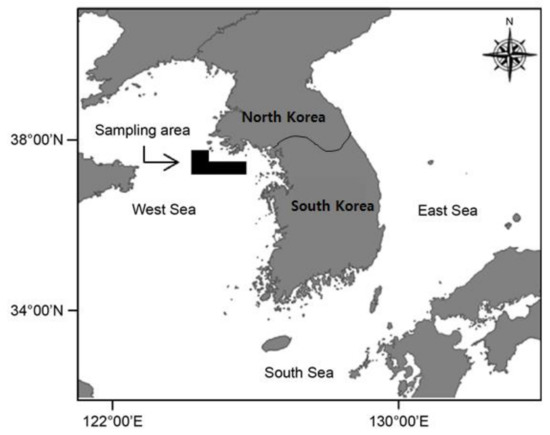
Figure 2.
Location of the ocellate spot skate Okamejei kenojei sampling area in the present study.
2.2. Gonad Development Examination
To investigate the gonadal development process, the maturity stage of the gonads of each individual was determined visually based on size, color, and egg size. The gonads (i.e., ovaries) of each female were assigned to one of five maturity stages (immature, maturing, mature, ripe, or spawning and spent) as shown in Figure 3. More specifically, immature ovaries were light pink, with blood vessels, and contained dark pink tissue instead of eggs. Maturing ovaries were light pink and contained a few small white eggs. Mature ovaries were larger and contained both small and large eggs. Ripe ovaries were the largest and white, with eggs that were no longer wrapped together, and spawning and spent ovaries were dark pink, with darkened tissue around the eggs. The ovaries were thin and loose, covered with a transparent membrane, and the eggs were small and recovered. Meanwhile, the gonads (i.e., testis) of male specimens were assigned to one of three stages (immature, mature, or ripe) as shown in Figure 3.
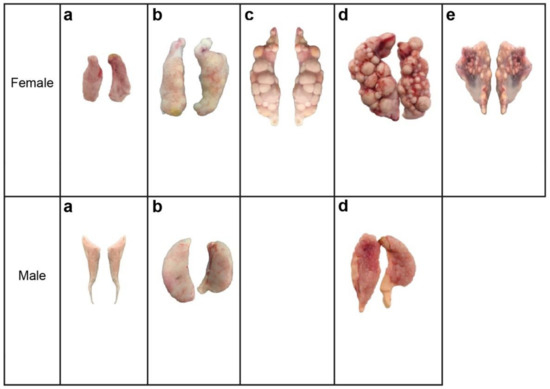
Figure 3.
Gonad maturation stages of ocellate spot skate Okamejei kenojei specimens collected from the West Sea of Korea in 2019 and 2020 (Immature—a; Maturing—b; Mature—c; Ripe—d; Spawning and spent—e).
2.3. Spawning Season
To estimate the spawning period, the disc width (DW, 0.1 cm), body weight (BW, 0.1 g), and gonad weight (GW, 0.01 g) of each specimen were measured, and the monthly gonadosomatic index (GSI) was estimated as follows:
2.4. Measuring Egg Capsule Characteristics
All female individuals of O. kenojei in which the egg capsule was found through dissection were used as samples to investigate the egg capsule characteristics. After measuring the length, half-width, and weight of each individual, an incision was made in the abdomen to extract the egg capsules. The ovary diameter was measured and the structure and characteristics of the egg capsules were observed. At the same time, the number of eggs was counted.
2.5. DW and Length at Maturity
The relative frequency of samples at 50% maturity was obtained as the ratio of mature individuals by dividing the DW class by 1 cm during the spawning period. After calculating the percentage of maturity of the ocellate spot skate during the spawning period, they were estimated using logistic curves of 50%, 75%, and 97.5% maturity.
where Pi represents the maturation rate of full-length class i, b is a constant, DW is the body width, and DWt is the variation in the body width. Microsoft Excel 2016 (Micro soft Inc., Washington, USA) solver was used to determine the mature length value, and the constants were estimated by setting the GRG nonlinear least-squares method as the solution, the degree of convergence to 0.0001, the differential coefficient to the center, the population size to 100, and the random initial value to 0.
2.6. Statistical Analyses
For statistical significance, the ANOVA test was performed using the SPSS statistical program (SPSS Inc., Chicago, IL, USA), and differences were considered significant when p < 0.05, through post hoc Tukey’s (T) test.
3. Results
3.1. Study Specimens
The 1234 O. kenojei specimens collected from January 2019 to December 2020 included 654 females and 580 males (Table 1). The DW of females ranged from 17.8 to 36.9 cm (mean: 28.5 cm), with most (54.3%) between 25.0 and 30.0 cm. Meanwhile, the DW of males ranged from 19.3 to 34.5 cm (mean: 28.1 cm), with most (64.1%) between 25.0 and 30.0 cm. The mean BW was 575.8 g for females and 537.1 g for males. There was no significant difference in the mean DW values of the male and female specimens (t-test, p > 0.05) (Figure 4).

Table 1.
Mean and range of DW (cm) and weight (g) of ocellate spot skate Okamejei kenojei specimens (n) collected from the West Sea of Korea in 2019 and 2020.
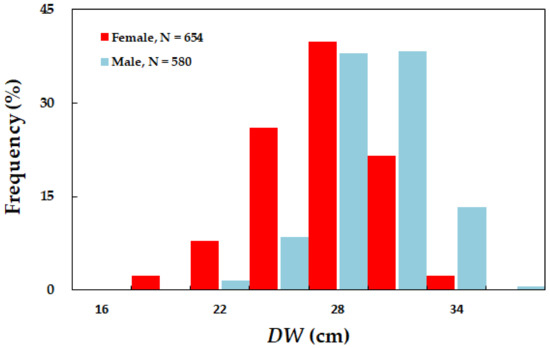
Figure 4.
Frequency distribution of DW of ocellate spot skate Okamejei kenojei in the West Sea of Korea.
The DW–BW relationships showed no significant difference between sexes (p < 0.05) and could be estimated as:
BW = 3.4 × 10−3 DW 3.58 (R2 = 0.93; N = 654; p < 0.05) for females;
BW = 5.7 × 10−3 DW 3.42 (R2 = 0.93; N = 580; p < 0.05) for males;
BW = 4.3 × 10−3 DW 3.51 (R2 = 0.92; N = 1234; p < 0.05) for both sexes
See Figure 5.
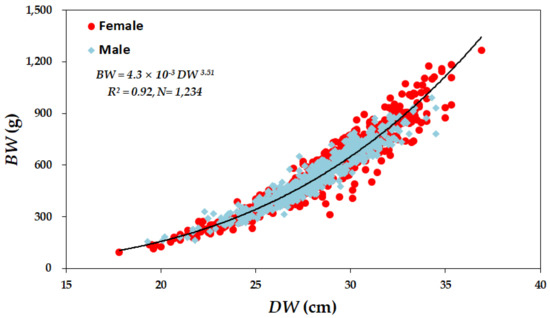
Figure 5.
Relationship between BW and DW of ocellate spot skate Okamejei kenojei in the West Sea of Korea.
3.2. Temporal Variation in Gonad Maturity and GSI
Specimens with immature ovaries were collected in August, but by October, most collected specimens possessed maturing gonads. Specimens with mature gonads were observed in February, with ripe gonads observed from May to July and specimens with spawning and spent gonads observed from July to August (Figure 6). Furthermore, in the female specimens, GSI increased in March, then increased rapidly from April to May, reaching a maximum average value of 4.30. Hereafter there was a gradual decrease, with the lowest average value of 0.55 occurring in July (Figure 7). In the male specimens, GSI peaked in January and decreased thereafter, until it increased in September. Thus, GSI increased rapidly from October, coinciding with the high proportion of specimens with maturing-stage gonads, and peaked in April, preceding the development of ripe-stage gonads. In addition, GSI reached its minimum in July, corresponding with the increasing proportion of individuals with spawning and spent stage gonads. Although the monthly maturity stage of O. kenojei appearing in the West Sea differed depending on the season, GSI peaked in April and May and decreased thereafter.

Figure 6.
Temporal distribution of maturation stages in ocellate spot skate Okamejei kenojei specimens collected from the West Sea of Korea between January 2019 and December 2020.
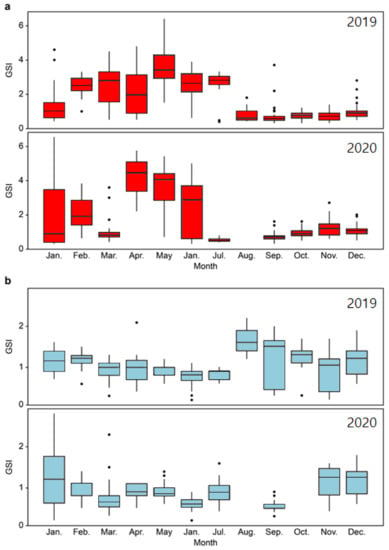
Figure 7.
Temporal variation in the gonadosomatic index (GSI) of female (a) and male (b) ocellate spot skate Okamejei kenojei specimens collected from the West Sea of Korea in 2019 and 2020.
3.3. Morphological Characteristics and Occurrence of Egg Capsules
The egg capsule of ocellate spot skate O. kenojei was blackish brown in color, rectangular in shape with a long projection at each corner. The horns projecting from the front of the egg capsule were long and thin and easily damaged during handling, while those on the rear of the capsule were curled into a hook shape. The yolk inside the egg capsule was milky white in color.
The total number of egg capsules was 179; of these, 108 were obtained in 2019 and 71 in 2020. Each egg-bearing female contained 1–4 egg capsules, with 1 egg yolk in each egg.
Examining the occurrence of egg capsules during different months of the survey period revealed that the occurrence rate increased to 1.6% (of the number of females) from March and reached a maximum of 56.8% in July (Table 2).

Table 2.
Number of egg capsules observed in the gonads of ocellate spot skate Okamejei kenojei specimens collected from the West Sea of Korea in 2019 and 2020.
To verify the morphological characteristics of the egg capsules, measurements were taken from 96 O. kenojei egg capsules collected in 2019 (excluding damaged individuals) (Figure 8). The weight of each egg capsule ranged from ~1.1 to 8.2 g, with an average of 5.3 g. Each egg capsule was ~67.7–115.7 mm in length; the yolk room (where the yolk grows) was ~38.0–52.6 mm in length and ~22.1–34.6 mm in width (Figure 8). The anterior and posterior horns of the capsule were ~20.1–28.7 mm and ~18.9–28.9 mm-wide, respectively. Long fissure were developed at the front and rear edges of the capsule, with lengths of ~7.2–57.7 mm for the anterior part and ~10.9–27.7 mm for the posterior part (Table 3).
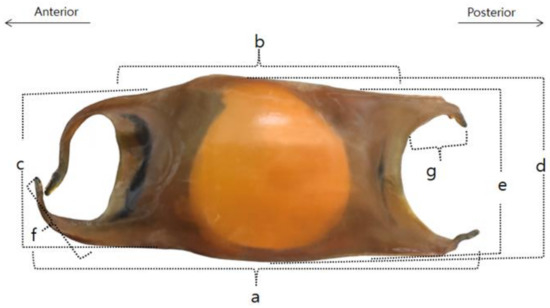
Figure 8.
Diagrammatic representation of ocellate spot skate Okamejei kenojei egg capsule (dorsal view) with measurements indicated in parenthesis. a: Total length (85.3 mm), b: Central chamber length (45.1 mm), c: Width of anterior horn (25.0 mm), d: Width of capsule (30.1 mm), e: Width of posterior horn (23.5 mm), f: Length of anterior fissure (19.6 mm), g: Length of posterior fissure (26.3 mm).

Table 3.
Biometric comparison of various parts of the egg capsule of ocellate spot skate Okamejei kenojei. The numbers in parenthesis indicate the range of measurements from the 2019 specimens (n = 96); unit: mm.
3.4. Disc Width at Maturity
At 50%, 75%, and 97.5% maturity, female specimens had DWs of 26.6, 27.9, and 30.8 cm, respectively, whereas the male specimens had DWs of 26.2, 27.5, and 30.7 cm, respectively (Figure 9). Furthermore, 100% of females and males over 31 and 32 cm participated in spawning.
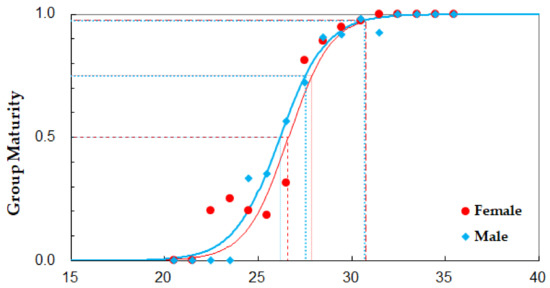
Figure 9.
Logistic curve showing the relationship between maturity and DW in ocellate spot skate Okamejei kenojei specimens collected from the West Sea of Korea in 2019 and 2020.
4. Discussion
The aims of the present study were to investigate the gonadal development process and size at maturity of O. kenojei in the West Sea of Korea. Accordingly, the main spawning period was estimated to occur during June and July, corresponding with the highest frequency of egg capsule observation. Interestingly, a previous study [5] conducted in a different part of the East China Sea reported that the main spawning period of O. kenojei occurred during November and December, in contrast to the results of this study. However, it is possible that this discrepancy was due to geographic differences.
The reproductive biology of other members of the family Rajidae has also been reported. For example, Jang [6] reported that the GSI of Beringraja pulchra (Liu 1932) from the West Sea peaked in January, whereas spawning occurred from May to August, with most of the activity occurring in May and June. Thus, the pattern of spawning from late spring to early summer was similar to that of O. kenojei. Meanwhile, Coleman et al. [2] reported that Beringraja koreana (Jeong and Nakabo 1997) males in the Southwest Sea were mature year-round, whereas females carried egg capsules in May and November but not during the summer. Serra-Pereira et al. [7] reported that Beringraja clavata (Linnaeus 1758) males in the Portuguese waters of the North Atlantic Ocean were also mature year-round, but their GSI peaked in August and September, with the main spawning period in October [7]. For each member of the family Rajidae, the spawning period is defined as the period after peak GSI, associated with high egg capsule observation. In the present study, specimens with ripe ovaries were observed during June and July, and the GSI was lowest in individuals with spawning and spent ovaries. Beringraja pulchra and other family members reportedly spawn multiple times with a spawning period, entering the spawning and spent stage only at the end of the period [2,8]. Based on these data, additional studies are necessary to increase the accuracy of the estimated spawning period of O. kenojei. Reorganization of the survey area and an increase in survey samples could increase the accuracy of future studies.
The egg capsules of O. kenojei examined in this study were blackish-brown and rectangular in shape, with a milky-white yolk color. Individuals contained 1 to 4 eggs capsules, with only one yolk appearing in each capsule. The egg capsule characteristics were compared with those of B. pulchra [9]. The egg of B. pulchra has a longer capsule length (~146.1–174.9 mm) than that of O. kenojei (~67.7–115.7 mm) and was wider in the back than in the front. The egg capsule of B. pulchra had a long arrowhead shape and was yellowish-brown in color, lighter than that of O. kenojei. Eggs of B. pulchra may contain 2–6 yolks; however, the number of egg capsules was not mentioned [6]. Comparing the two members, egg yolks in the capsule had similar shapes but differed in size and number. The method of contributing to spawning is thought to be similar for O. kenojei and B. pulchra. Additional research would be required to determine the number of egg capsules in multi-spawning O. kenojei.
The frequency with which egg capsules were observed in the O. kenojei specimens increased from March to its peak (56.8%) in July, and no egg capsules were observed from October to December. B. pulchra reportedly spawns year-round, with a relatively high frequency of egg capsule observation from April to June, corresponding with the main spawning period of O. kenojei [6]. To confirm whether females produce more than one egg capsule throughout the year, it is necessary to assess the number egg capsules with an increased number of mature female specimens. Such future studies could confirm whether O. kenojei actually spawn during a period where no egg capsules were observed.
The DWs of O. kenojei females and males at 50% maturity were 27.5 and 18.6 cm, respectively. According to NFRDI (2009), the DW and total length of O. kenojei at 50% maturity were 26.9 cm and 45.0 cm, respectively [10]. Although the results did not show a significant size difference at 50% maturity, differences may correspond with factors that affect growth and reproduction such as overfishing, water temperature, food organisms, and environmental quality. In addition, the total length of B. clavata 50%-maturity females and males in the Portuguese waters of the North Atlantic Ocean were 78.4 cm and 67.6 cm, respectively [7], and the total length of Dipturus chinensis (Basilewsky 1855) females and males in the sea off the coast of southern Chile were 103.9 and 89.7 cm, respectively [11]. Thus, in comparison to other family members, O. kenojei begins spawning at a relatively small size.
This study provides basic data (spawning period and size at maturity) for evaluating the O. kenojei population of the central waters of the West Sea as an economically important fishery resource. The study also provides data for research on other fish species, regarding their condition, size, age, and growth through mature spawning [12,13,14,15,16,17,18]. Further studies are required on O. kenojei populations occurring in different areas and under additional ecological conditions. Additionally, unlike the gonads of other fish, O. kenojei gonads become liquid and burst when the ovaries are fully matured. Therefore, we intend to conduct additional research incorporating histological analysis.
5. Conclusions
This study aimed to investigate the gonadal development process and size at maturity of O. kenojei in the West Sea of Korea. Accordingly, the main spawning period was estimated to occur during June and July. Egg capsules were observed in the O. kenojei specimens with greater frequency from March to its peak (56.8%) in July, and no egg capsules were observed from October to December. The DW of female specimens at 50% maturity was 26.6 cm, whereas male specimens had a DW of 26.2 cm.
Author Contributions
Conceptualization, B.-I.Y. and M.-J.K.; methodology, B.-I.Y. and D.-H.C.; software, B.-I.Y.; validation, K.-H.H., S.-H.L. and D.-H.C.; formal analysis, B.-I.Y.; investigation, B.-I.Y. and D.-H.C.; resources, S.-J.L.; data curation, B.-I.Y. and D.-H.C.; writing—original draft preparation, B.-I.Y.; writing—review and editing, B.-I.Y. and M.-J.K.; visualization, S.-J.L. and D.-H.K.; supervision, K.-H.H. All authors have read and agreed to the published version of the manuscript.
Funding
This research was a part of the project entitled “Survey of coastal fisheries resources and marine environmental ecology in the Yellow Sea” (R2022036), which was funded by the National Institute of Fisheries Science (NIFS), Republic of Korea.
Institutional Review Board Statement
The study was conducted in accordance with the regulations on research ethics of the National Institute of Fisheries Science. We only used specimens from the fish market which were already dead.
Informed Consent Statement
Not applicable.
Data Availability Statement
Not applicable.
Acknowledgments
This work was funded by National Institute of Fisheries Science (R2022036). We would like to thank the researchers at the West Sea Fisheries Research Institute for their assistance in analyzing the sample and the anonymous reviewers and editors who provided comments to improve the quality of the paper.
Conflicts of Interest
The authors declare no conflict of interest.
References
- Korea Ocean Research and Development Institute. Yellow Sea Large Marine Ecosystem; KORDI: Busan, Korea, 1998. [Google Scholar]
- Kim, J.K.; Sim, D.S.; Jeong, S.D. Sexual maturity of Raja koreana (Elasmobranchii, Rajoidei) from Korea. Korean J. Ichthyol. 2005, 17, 229–235. [Google Scholar]
- Coleman, F.C.; Koenig, C.C.; Collins, L.A. Reproductive styles of shallow-water groupers (Pisces: Serranidae) in the eastern Gulf of Mexico and the consequences of fishing spawning aggregations. Environ. Biol. Fishes 1996, 47, 129–141. [Google Scholar] [CrossRef]
- Sadovy, Y.J. Reproduction of reef fishery species. In Reef Fisheries; Polunin, N.V., Roberts, C.M., Eds.; Chapman & Hall Fish and Fisheries Series; Springer: Dordrecht, The Netherlands, 1996; Volume 20, pp. 15–59. [Google Scholar]
- Yamada, U.; Tokimura, M.; Horikawa, H.; Nakabo, T. Fishes and Fisheries of the East China and Yellow Seas; Tokai University Press: Tokyo, Japan, 2007. [Google Scholar]
- Jang, M.H. Age and Growth of Mottled Skate Bering Rajapulchra in the Yellow Sea of Korea; Korean Inha University: Incheon, Korea, 2014. [Google Scholar]
- Serra-Pereira, B.; Figueiredo, I.; Leonel, G. Maturation, fecundity, and spawning strategy of the thornbackray, Raja clavata: Do reproductive characteristics vary regionally? Mar. Biol. 2011, 158, 2187–2197. [Google Scholar] [CrossRef]
- Mcphie, R.P.; Campana, S.E. Reproductive characteristics and population decline of four species of skate (Rajidae) off the eastern coast of Canada. J. Fish Biol. 2009, 75, 223–246. [Google Scholar] [CrossRef] [PubMed]
- Jo, H.S.; Kang, E.J.; Cho, Y.R.; Seo, H.C.; Im, Y.J.; Hwang, H.J. Characteristics of multi-embryo egg capsule and larvae of mottled skate Raja pulchra from Korea. Korean J. Ichthyol. 2010, 22, 217–224. [Google Scholar]
- National Fisheries Research and Development Institute (NFRDI). Investigation Report for Prohibition Regulations of Marine Fishes & Plants by Species in 2009; NFRDI: Busan, Korea, 2009. [Google Scholar]
- Quiroz, J.C.; Wiff, R.; Céspedes, R. Reproduction and population aspects of the yellownose skate, Dipturus chilensis (Pisces, Elasmobranchii: Rajidae), from southern Chile. J. Appl. Ichthyol. 2009, 25, 72–77. [Google Scholar] [CrossRef]
- Kjesbu, O.S.; Klungsoyr, J.; Kryvi, H.; Witthames, P.R.; Walker, M.G. Fecundity, atresia, and egg size of captive Atlantic cod (Gadus morhua) in relation to proximate body-composition. Can. J. Fish. Aquat. Sci. 1991, 48, 2333–2343. [Google Scholar] [CrossRef]
- Solemdal, P. Maternal effects—A link between the past and the future. J. Sea Res. 1997, 37, 213–227. [Google Scholar] [CrossRef]
- Trippel, E.A.; Kjesbu, O.S.; Solemdal, P. Effects of adult age and size structure on reproductive output in marine fishes. In Early Life History and Recruitment in Fish Populations; Chambers, R.C., Trippel, E.A., Eds.; Chapman & Hall Fish and Fisheries Series; Springer: Dordrecht, The Netherlands, 1997; Volume 21, pp. 31–62. [Google Scholar]
- Marshall, C.T.; Kjesbu, O.S.; Yaragina, N.A.; Solemdal, P.; Ulltang, O. Is spawner biomass a sensitive measure of the reproductive and recruitment potential of Northeast Arctic cod? Can. J. Fish. Aquat. Sci. 1998, 55, 1766–1783. [Google Scholar] [CrossRef]
- Marshall, C.T.; Frank, K.T. The effect of interannual variation in growth and condition on haddock recruitment. Can. J. Fish. Aquat. Sci. 1999, 56, 347–355. [Google Scholar] [CrossRef]
- Bromley, P.J. Growth, sexual maturation and spawning in central North Sea plaice (Pleuronectes platessa L.), and the generation of maturity ogives from commercial catch data. J. Sea Res. 2000, 44, 27–43. [Google Scholar] [CrossRef]
- Morgan, M.J. The relationship between fish condition and the probability of being mature in American plaice (Hippoglossoides platessoides). ICES J. Mar. Sci. 2004, 61, 64–70. [Google Scholar] [CrossRef]
Publisher’s Note: MDPI stays neutral with regard to jurisdictional claims in published maps and institutional affiliations. |
© 2022 by the authors. Licensee MDPI, Basel, Switzerland. This article is an open access article distributed under the terms and conditions of the Creative Commons Attribution (CC BY) license (https://creativecommons.org/licenses/by/4.0/).